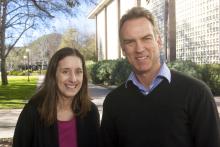
Study by UCSB Economists Suggests ‘Competition Aversion' Does Not Keep Women Out of the Running for Top Jobs
Women are reaching the upper echelons of business in record numbers –– Marissa Mayer at Yahoo!, Meg Whitman at Hewlett-Packard, Ginni Rometty at IBM, and Rosalind Brewer at Sam's Club, to name a few. Even so, women comprise a mere 4 percent of the chief executive officer positions at Fortune 500 companies.
Economists at UC Santa Barbara are exploring some of the reasons behind this continuing disparity, and they're using a one-mile race as their data source. Their findings appear in the current issue of the journal Economic Inquiry.
"A lot of the literature tries to explain the relatively low number of female CEO's," said Rodney J. Garratt, professor of economics and co-author of the study. "People have studied various aspects, including different attitudes toward competition. To rise to the CEO level, you have to compete for promotions, and some researchers find differences between men and women in terms of their willingness to enter competitions."
As a regular participant in Santa Barbara's State Street Mile, a short-distance race in which men and women self-select their placement in individual categories, Garratt noticed that the men's elite group was often populated by a large field of runners that included some who did not run the suggested elite standard time. That wasn't the case, however, with the women's elite group. Far fewer women ran in the elite race, and none ran slower than the suggested elite standard time. At first, it seemed that the tendency for some women to forgo the elite race might be preventing them from winning an elite race cash prize. But a closer look revealed something surprising.
Garratt, along with co-author Catherine Weinberger, a scholar with UCSB's Institute for Social, Behavioral, and Economic Research, and Nicholas Johnson, a former undergraduate student at UCSB, decided to take a closer look at this phenomenon, using data on the sex, age, and mile time of each participant in the elite races and age-group races. As it turns out, young men are the runners most likely to participate in races for which they are not qualified.
This falls in line with what they would expect, Garratt said, citing studies including one in which men and women were given a choice between being paid based on how much they competed or being paid a larger sum but only if they won a competition. Women tended to opt out of the competition, while men were often overconfident. "But with the State Street Mile, there's an interesting twist: Most elite women –– the ones who have the greatest chance of winning their races –– do, by and large, sign up for the elite race." What's also true, however, is that many women who qualify for the elite race choose to place themselves in a less competitive category, while men who are unlikely to win prefer to run in the elite competition anyway.
Weinberger noted, "This would be like saying all the women who have the chance of being promoted up the hierarchy to CEO are going to be in the race, along with both the most qualified men and a lot of men who are unlikely to be promoted. The fact that there aren't a lot of women choosing to be in that track isn't necessarily what keeps women out of the CEO office. When it matters, the women are just as competitive as the men."
Because they had data for each runner over seven years of races, Garratt and Weinberger were able to eliminate an alternative explanation for women's tendency to avoid the elite races. "We ruled out the possibility that the women are less certain than the men about how fast they can run, and simply misjudge their ability," Weinberger said. "When we compared the people who have run the race before to people who are running the race for the first time, we didn't see any difference between those two groups in their tendency to select the elite race."
In this study, the only factor Garratt and Weinberger examined was the willingness of individuals to self-select into a more competitive race. "If our work can be extrapolated from this competitive setting to the real labor market, then it suggests that there are other reasons for the underrepresentation of women in CEO positions," Weinberger said.
Related Links



